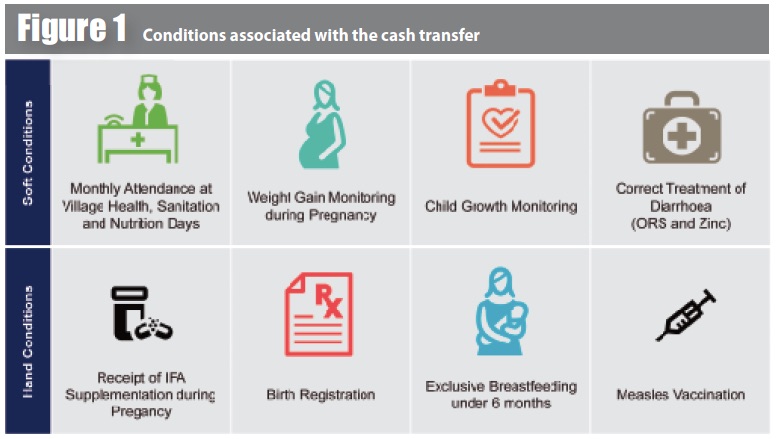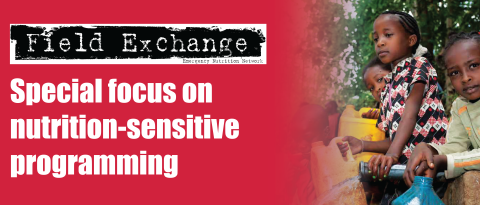Doing cash differently: how cash transfers can transform humanitarian aid
Summary of research1
Location: Global
What we know: Humanitarian aid is increasingly provided in the form of cash assistance. Unconditional and multi-purpose cash programming allows beneficiaries to choose what resources to procure, making the intervention, by definition, multi-sectoral.
What this article adds: A recent report of the High Level Panel on Humanitarian Cash Transfers evidences that humanitarian cash transfers can be provided to people safely, efficiently and accountably. Cash is spent sensibly by recipients and makes limited humanitarian resources go further. Greater use of unrestricted cash assistance has multiple advantages in terms of efficiencies, speed of response, monitoring, value for money, meeting needs, autonomy of affected populations and accountability. Expansion of the use of cash transfers should be accompanied by specific measures to catalyse wider change and better coordination of the humanitarian system and related institutional architecture. Twelve recommendations are made centred on greater and more efficient cash transfers (with strong, locally accountable systems) and different funding streams (to enable reform and realise opportunities).
 This report of the High Level Panel on Humanitarian Cash Transfers explains why giving aid directly in the form of cash is often a highly effective way to reduce suffering in places experiencing humanitarian emergencies and to make limited humanitarian aid budgets go further. The panel describes the problem of a widening gap between humanitarian need and humanitarian assistance and presents the evidence and experience of humanitarian cash transfers. The panel urges the humanitarian community to give more aid as cash and argues for a more coordinated system of cash transfers that will precipitate broader reform of the humanitarian system. Finally, the report presents twelve clear recommended actions of the panel for actors in the humanitarian community.
This report of the High Level Panel on Humanitarian Cash Transfers explains why giving aid directly in the form of cash is often a highly effective way to reduce suffering in places experiencing humanitarian emergencies and to make limited humanitarian aid budgets go further. The panel describes the problem of a widening gap between humanitarian need and humanitarian assistance and presents the evidence and experience of humanitarian cash transfers. The panel urges the humanitarian community to give more aid as cash and argues for a more coordinated system of cash transfers that will precipitate broader reform of the humanitarian system. Finally, the report presents twelve clear recommended actions of the panel for actors in the humanitarian community.
The ‘humanitarian system’ comprises a web of humanitarian aid agencies, donor governments and national organisations that employs over 450,000 people and spends about USD25 billion per year. Most humanitarian aid is spent in protracted crises, rather than on quick-onset disasters. 89% of humanitarian aid goes to places that have required humanitarian funding for more than three years, and 66% of humanitarian aid is spent in places that have needed it for eight years or more. The humanitarian system is being stretched and the gap between needs and funding is widening. Humanitarian organisations have traditionally supported crisis-affected people with physical commodities: food, shelter, water, tents, clothing and medical help. However, with changes in technology, growing access to financial services, greater urbanisation and the emergence of government safety nets, unprecedented opportunities now exist to reach people in new ways.
Cash transfers are among the most well-researched and rigorously-evaluated humanitarian tools of the last decade. The Panel identified more than 200 resources and studies, including randomised control trials, which evaluate the effectiveness of cash transfers. These provide evidence about the feasibility, cost and effectiveness of cash transfers in humanitarian settings. This evidence is compelling and shows that, in most contexts, humanitarian cash transfers can be provided to people safely, efficiently and accountably. Furthermore, people spend cash sensibly, both women and men often prefer cash over other forms of assistance, and cash is no more prone to diversion than in-kind assistance, especially when delivered through digital payments. Evidence also shows that local markets have responded to cash injections without causing inflation, cash transfers have generated positive impacts on local economies and cash can be delivered in increasingly affordable, secure and transparent ways.
Cash transfers can also make limited humanitarian resources go further. It usually costs less to get cash transfers to people than in-kind assistance because aid agencies do not need to transport and store relief goods. A four-country study comparing cash transfers and food aid found that 18% more people could be assisted at no extra cost if everyone received cash instead of food (Margolies & Hoddinott, 2014). As the scale of cash grows and it becomes more efficient, it will become even cheaper.
In the light of this evidence, the Panel concludes that greater use of humanitarian cash transfers in the settings where they are appropriate, without restrictions and delivered as electronic payments wherever possible, would: align the humanitarian system better with what people need; increase the transparency of humanitarian aid; increase accountability of humanitarian aid, both to affected populations and to the tax-paying public in donor countries; reduce the costs of delivering humanitarian aid and so make limited budgets go further; support local markets, jobs and incomes of local producers; increase support for humanitarian aid from local populations; increase the speed and flexibility of humanitarian response; increase financial inclusion by linking people with payment systems; and, most importantly, provide affected populations with choice and more control over their own lives. The Panel urges the humanitarian community not to use the rare and usually temporary cases where giving people cash is not the best option as bad excuses for not using cash in the majority of cases where it is appropriate. Humanitarian actors should use cash as the benchmark against which other forms of humanitarian aid are judged and should always ask: Why not cash? If not now, when?
The humanitarian system has made some important progress towards using cash transfers. Although we do not know the exact amounts, the Panel estimates that cash and vouchers together have risen from less than 1% in 2004 to around 6% of total humanitarian spending today. UN agencies, the Red Cross movement, international and southern non-governmental organisations (NGOs) and governments of disaster-affected countries have all provided cash transfers in a variety of challenging contexts. Left to its own devices, the use of cash transfers may continue to increase, but the panel warns that progress will be far too slow. Furthermore, change will be inhibited by the institutional architecture in which humanitarian agencies currently operate.
 A coordinated expansion of humanitarian cash transfers offers the attractive prospect of helping to accelerate long-overdue changes in the humanitarian system to break down counterproductive divisions between clusters, improve coordination, reduce costs, work more closely with the private sector, make humanitarian aid more transparent, and make the system more accountable to its beneficiaries. However, unless we take conscious steps to avoid it, the humanitarian system is likely to reproduce its existing structural problems in the delivery of cash. For example, in Lebanon in 2014, more than 30 different aid agencies provided cash transfers and vouchers for 14 different objectives, ranging from winterisation and food to legal assistance. An expansion of the use of cash transfers should therefore be accompanied by specific measures to catalyse wider change and better coordination.
A coordinated expansion of humanitarian cash transfers offers the attractive prospect of helping to accelerate long-overdue changes in the humanitarian system to break down counterproductive divisions between clusters, improve coordination, reduce costs, work more closely with the private sector, make humanitarian aid more transparent, and make the system more accountable to its beneficiaries. However, unless we take conscious steps to avoid it, the humanitarian system is likely to reproduce its existing structural problems in the delivery of cash. For example, in Lebanon in 2014, more than 30 different aid agencies provided cash transfers and vouchers for 14 different objectives, ranging from winterisation and food to legal assistance. An expansion of the use of cash transfers should therefore be accompanied by specific measures to catalyse wider change and better coordination.
The panel puts forward 12 recommendations, displayed in Box 1, that chart the steps needed to accelerate the use of cash transfers and realise the broader benefits of their greater use. The first recommendation – to give more unconditional cash transfers – allows beneficiaries to choose what resources to procure, making the intervention, by definition, multi-sectoral and with the potential to address the underlying causes of malnutrition (nutrition-sensitive).
The panel conclude that host governments, donor governments, international and local NGOs and UN agencies should all seize this opportunity to bring about more rapid and substantial reform, in the service of our collective humanitarian goals.
Box 1: The 12 recommendations of the high-level panel on cash transfers
A. More cash transfers
1. Give more unconditional cash transfers. The questions should always be asked: ‘why not cash?’ and ‘if not now, when?’
2. Invest in readiness for cash transfers in contingency planning and preparedness.
B. More efficient cash transfers, delivered through stronger, locally accountable systems
3. Measure how much aid is provided as cash transfers and explicitly distinguish this from vouchers and in-kind aid.
4. Systematically analyse and benchmark other humanitarian responses against cash transfers.
5. Leverage cash transfers to link humanitarian assistance to longer-term development and social protection systems.
6. Capitalise on the private sector’s expertise in delivering payments.
7. Where possible, deliver cash digitally and in a manner that furthers financial inclusion.
8. Improve aid agencies’ data security, privacy systems and compliance with financial regulations.
9. Improve coordination of cash transfers within the existing system.
10. Implement cash programmes that are large-scale, coherent and unconditional, allowing for economies of scale, competition and avoiding duplication.
C. Different funding to transform the existing system and open up new opportunities
11. Wherever possible, make humanitarian cash transfers central to humanitarian crisis response as a primary component of Strategic Response Plans, complemented by in-kind assistance if necessary.
12. Finance the delivery of humanitarian cash transfers separately from assessment, targeting and monitoring.
Footnotes
1 ODI Centre for Global Development. (2015). Doing cash differently: how cash transfers can transform humanitarian work: Report of the High Level Panel on Humanitarian Cash Transfers. September 2015.
References
Margolies, M. and Hoddinott, J. (2014). Costing alternative transfer modalities, Journal of Development Effectiveness. DOI: 10.1080/19439342.2014.984745


